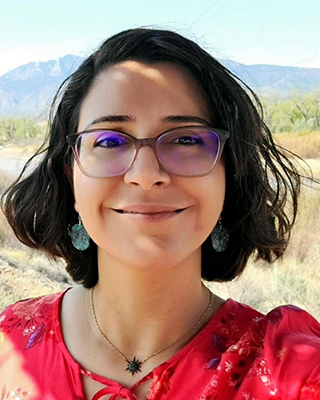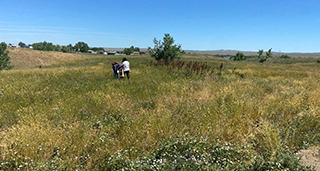March 12, 2024

Eliane El Hayek, Ph.D., attributes her success to her mentors. “To go far, we always need support and people who have our back, and I am thankful for all my mentors for providing that support,” she said. (Photo courtesy of Eliane El Hayek)
“In my home while growing up in Lebanon, science and education was a way for you to improve the world. It wasn’t about money, but how you could be a better person,” said Eliane El Hayek, Ph.D. “I think I took that to heart.”
Today, El Hayek is a research assistant professor at the University of New Mexico (UNM), where she works with the NIEHS-funded Superfund Research Program (SRP) Center to understand how exposures to heavy metals and tiny plastic particles known as microplastics affect human and plant health. Her work is aimed at improving environmental health among local Tribal communities that are disproportionately exposed to these contaminants.
Tracing Lead Pollution Using Cactuses
El Hayek earned her Ph.D. in environmental science from the Lebanese University and the University of Toulouse in France. Her doctoral work looked at cactuses as a potential tool for monitoring air pollution. She became interested in the topic after hearing that lead had been found in cactuses near a fertilizer production plant in Lebanon.
“I started to question, where is this lead coming from? Is it from the soil, or from particulate matter in the air when they make the fertilizer?” she recalled.
After plucking cactus samples from the vicinity of a fertilizer production plant and a highway in Lebanon, and an abandoned lead-zinc mine in Tunisia, El Hayek analyzed the roots and stems for lead. After testing the kinds of lead that the samples contained, she found that one source of the lead could be gasoline fumes.
“That’s what introduced me to the idea of environmental justice,” said El Hayek. “Leaded gasoline has been banned for years in other countries, but it was only banned in Lebanon in 2002. My research showed that there is still lead from gasoline in the air that we are affected by.”
Uranium, Microplastics, and Crow Nation
El Hayek arrived at UNM in 2016 for a postdoctoral fellowship with Jose Cerrato, Ph.D., director of the UNM SRP Center. Under his mentorship, she studied how plants absorb water contaminated with different forms of the toxic metal uranium. Her work supported SRP research involving the Jackpile Mine, an abandoned uranium mine and Superfund site only an hour away from UNM.

“There are Tribal communities that live right next to the mine that may be affected by metals in the air or in their water and food,” explained El Hayek. “I wanted to work on something that could be valuable for the people around me. I think working with the Superfund community has the potential to change the future for a generation of people who have struggled with environmental injustice.”
One research avenue she pursued was phytoremediation, or the removal of environmental contaminants by plants. In her work, El Hayek found that calcium played an important role in the movement of uranium in certain plant tissues. The finding could inform phytoremediation efforts around Jackpile Mine, she said.
In 2023, El Hayek and her co-investigator, Jorge Gonzalez-Estrella, Ph.D., received a pilot award from the NIEHS-funded Center for Native American Environmental Health Equity in Research and the National Institute on Minority Health and Health Disparities to examine effects of a different contaminant: microplastics. The project addresses concerns from members of the Crow Nation about pollution from Tribal waste management practices. Because trash is typically burned or disposed of in open-air sites, residents worried about potential exposures from the air, water, or wild herbs harvested for cultural or medicinal purposes.
In collaboration with John Doyle and Sara Plaggemeyer, instructors at Little Big Horn Community College, El Hayek’s team gathered sediment around the waste sites and extracted DNA from microbes in the soil. Using this DNA, the team can identify the types of microbes living there and evaluate the overall health of the soil, which ultimately influences human health, explained El Hayek. The team is in the process of gathering and analyzing data.
For El Hayek, a project highlight has been sharing research methodologies with instructors from Little Big Horn Community College.
“I love that we can train science educators, and they can bring these trainings back to their students,” said El Hayek. “I hope we can grow these connections, and inspire these students to pursue education and bring back their research to help their own communities.”
Pursuing a Multidisciplinary Approach
In June 2023, El Hayek’s research on the toxicity of microplastic inhalation was featured as an NIEHS Extramural Paper of the Month. The study found that sunlight changed the chemistry of microplastics, potentially increasing their toxicity when inhaled. According to El Hayek, the study was possible due to the expertise of peers and mentors in many different fields, including chemistry, medicine, engineering, and geology. She is currently studying different health effects from microplastics exposure with funding from NM-INSPIRES, an NIEHS-funded core center at UNM.
“Plastics have complex properties and require a multidisciplinary team effort to study. This means collaborating and working together to share knowledge with people who know more, to go in with your science and your eyes open,” said El Hayek.
Indeed, working across disciplines is foundational to environmental health research, according to El Hayek.
“Since I started my Ph.D. program, I’ve thought about how important it is to be willing to bridge fields together,” she said. “People can sometimes be afraid to cross disciplines, or even be very protective of their fields. But when you’re open to working across disciplines, you can find the unexpected. I think building a community of scientists like that is essential for the field of environmental health.”


